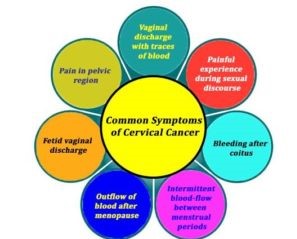Cervical cancer occurs when abnormal cells develop and spread in the cervix, (the lower part of the uterus).
CAUSES OF CERVICAL CANCER
Cancer is the result of the uncontrolled division and growth of abnormal cells. Most of the cells in our body have a set lifespan, and, when they die, the body generates new cells to replace them.
Abnormal cells can have two problems:
They do not die
They continue dividing
This results in an excessive buildup of cells, which eventually forms a lump, or tumor.
However, some risk factors might increase the risk of developing cervical cancer.
These include:
- HPV (Human Papilloma Virus): This is a sexually transmitted virus. More than 100 different types of HPV can occur, at least 13 of which may cause cervical cancer.
- Having many sexual partners or becoming sexually active early: The transmission of cancer-causing HPV types nearly always occurs as a result of sexual contact with an individual who has HPV. Women who have had many sexual partners generally have a higher risk of HPV infection. This increases their risk of developing cervical cancer.
- Smoking: This increases the risk of cervical cancer, as well as other types.
- A weakened immune system: The risk of cervical cancer is higher in those with HIV or AIDS, and people who have undergone a transplant, leading to the use of immunosuppressive medications.
- Birth control pills: Long-term use of some common contraceptive pills slightly raises a woman’s risk.
- Other sexually transmitted diseases (STD): Chlamydia, gonorrhea, and syphilis increase the risk of developing cervical cancer.

PREVENTION
A number of measures can help reduce the chances of developing cervical cancer.
- Human papillomavirus (HPV) vaccine
The link between the development of cervical cancer and some types of HPV is clear. If every female keeps to the current HPV vaccination programs, they could reduce the frequency of cervical cancer.
- Safe sex and cervical cancer
The HPV vaccine only protects against two HPV strains. Other strains can cause cervical cancer. Using a condom during sex helps protect from HPV infection.
- Cervical screening
Regular cervical screening might help a person identify and deal with signs of cancer before the condition can develop or spread too far. Screening does not detect cancer but indicates changes to the cells of the cervix.
- Having fewer sexual partners
The more sexual partners a woman has, the higher the risk of transmitting the HPV virus becomes. This can lead to a higher risk of developing cervical cancer.
- Delaying first sexual intercourse
The younger a woman is when she has sexual intercourse for the first time, the higher the risk of HPV infection becomes. The longer she delays it, the lower her risk.
- Stopping smoking
Women who smoke and have HPV face a higher risk of developing cervical cancer than people who do not.
- Diagnosis
Screening does not detect cancer but looks for abnormal changes in the cells of the cervix. Without treatment, some abnormal cells can eventually develop into cancer.



